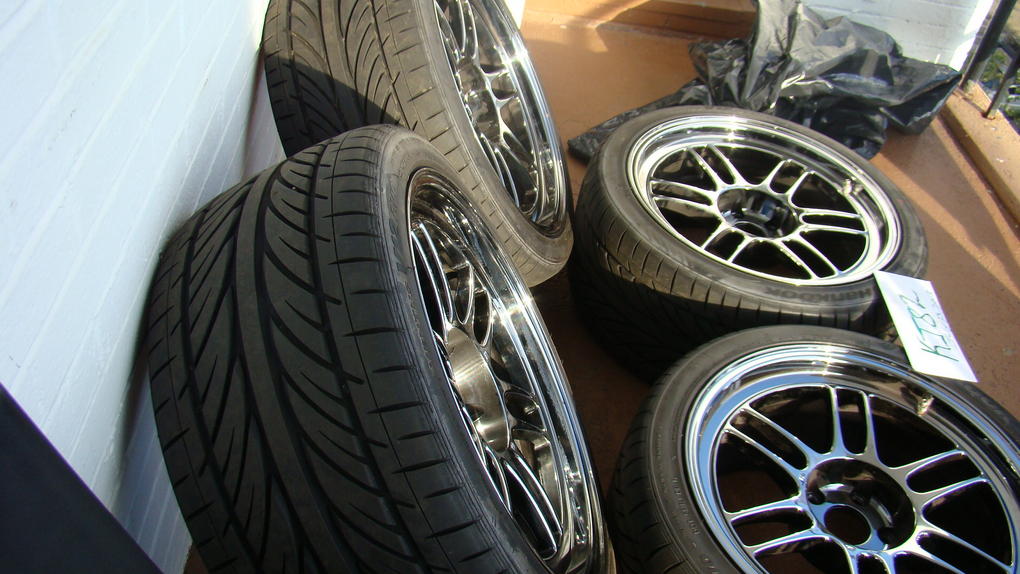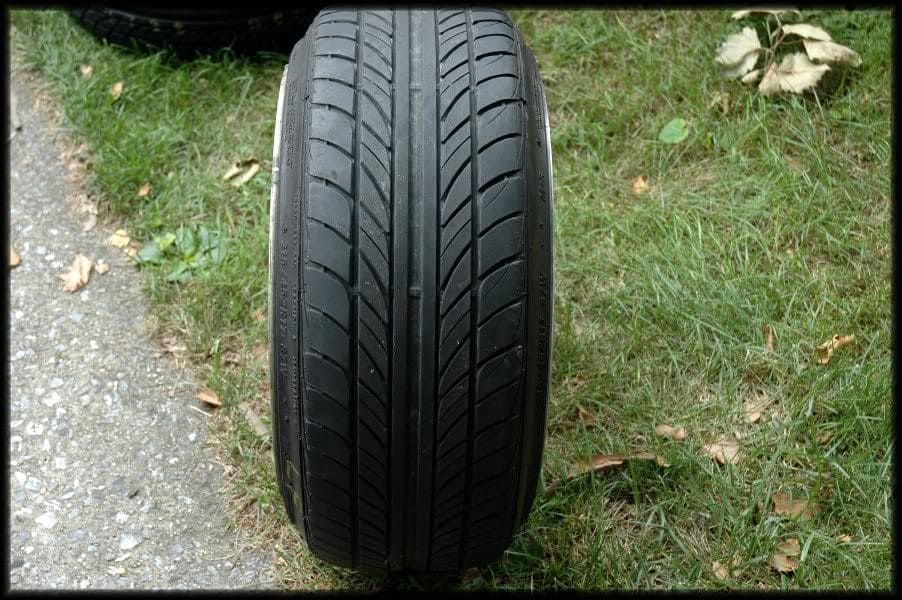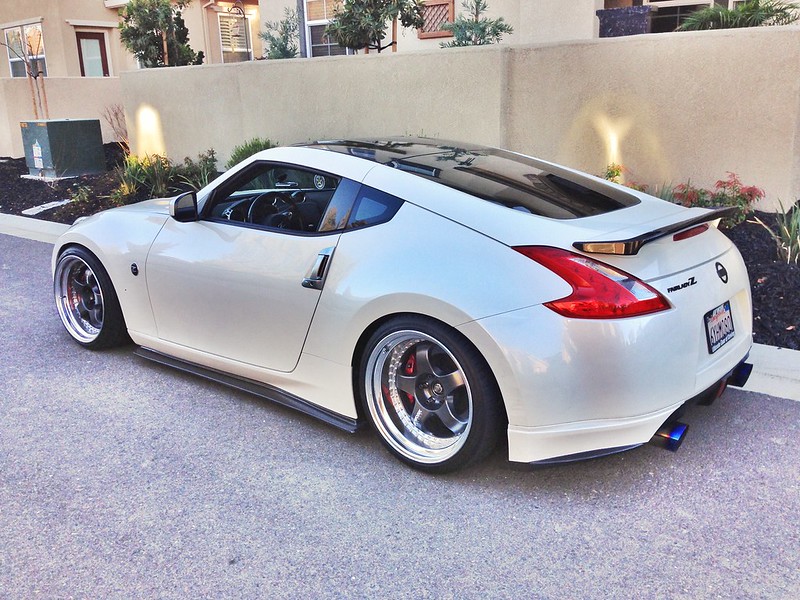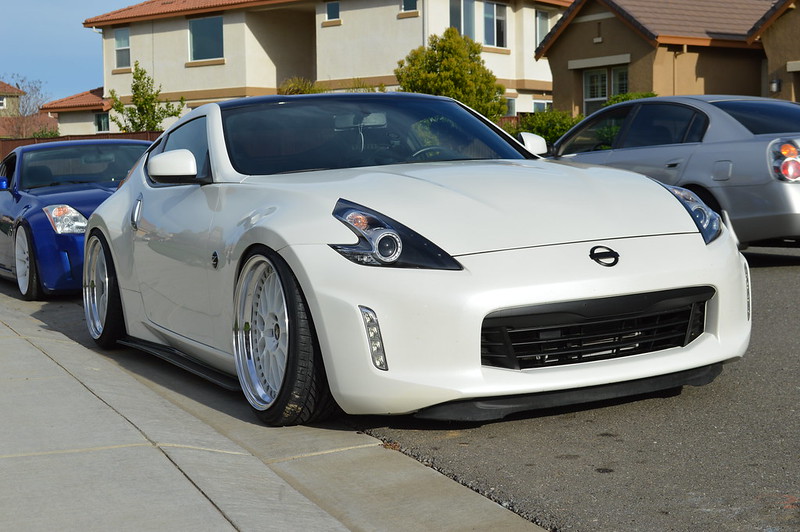I am consolidating several posts from another thread. The goal is to provide a starting point for anyone who wants to upgrade their wheels.
There are new posts constantly asking the same thing. This thread aims to eliminate this by educating those people so they can better make decisions.
================================================== ========
PART ONE: INTRODUCTION
Learning about wheel sizing is something you can do on your own. Wheel size cannot be considered without tire size.
First, a disclaimer:
You're gonna need to spend money. There's no wheel setup anyone here can recommend that will look good on a stock car with stock suspension. The car is too high, it's going to look like ****. Anyone that tells you otherwise was too cheap to do it right and is trying to make themselves feel better.
If you don't wanna spend money, keep your stock wheels and roll like the car came out of the factory. No shame there, and it's better than doing it wrong.
Onwards.
The simplest approach:
Read the threads on wheels pinned atop this section. Find one you like. Show us. We'll tell you how to copy that. No thinking required, just your credit card and the appropriate retailers.
The proper approach:
Learn how wheel fitment works. It's not hard. Follow along.
================================================== ========
PART TWO: WHAT ARE ALL THESE ******* NUMBERS?
Every wheel has a diameter, width, offset, and bolt pattern, expressed typically like this:
18 (diameter) x 10.5 (width), +18 (offset), 5x114.3 (bolt pattern)
You need 5x114.3 bolt pattern. Not negotiable.
Folks run anywhere from 18 to 20 inch diameter. For aesthetics, 20s are optimal because the wheel arches of our car are quite large. The compromise is that 20 inch wheels are more expensive. 20 inch tires are more expensive. Pay to play.

This example has 20's. The tire is slightly tucked under the fender. The arches are completely filled up.
18 inch wheels are cheaper and lighter, with a greater range of options, and an accompanying cheaper and wider set of tire options to go with that. They will not look good but they will work. Track folks all run 18's for cost effectiveness and wider tire compound selections.
Example:

Alwakra's car has square 18x10.5, +18 CE28N's with 275/40/18 tires and tracks his car regularly. This is an ideal wheel setup for that purpose. It does not look good.
19's offer a compromise, to a degree. Tire selection does not approach 18's. Price leans closer to 20's. Visually, better.
Next, width and offset. These two aspects cannot be considered independently of each other as they affect how the wheel sits in the wheel well.
Width is self explanatory. It's how wide the wheel is.
Offset is the orientation of the wheel relative to the hub (mounting surface for the wheels. The more higher the offset is, the further inward the wheel sits. A lower offset wheel will sit further from the hub, and stick out from the fender.
Example:
This red car has stock nismo wheels, 19x9.5 +40 in front and 19x10.5 +23 in rear

This white car has TE37's, 19x9.5 +22 front and 19x10.5 +12 in rear

Compare how the wheels fit each car. They have the identical diameter and width, but the white car has lower offset wheels that sit further away from hub, closer to the fender "outward."
Same width, lower offset = wheel sits further outward
Same offset, wider = outside edge also extends further outward.
That is how width and offset work; however, knowing the concept is relatively worthless without practical application to this car. Fortunately, the white car above illustrates a fairly standard drop and wheel size. That is a standard size for TE37's that any vendor would recommend you out of the box. You can fit it without too crazy an alignment, any many people have simply installed lowering springs and that size wheels and been "ok"
The more aggressive approach is to run even wider and lower offset wheels, with coilovers or air suspension that bring the car lower to the ground. This requires rolling your fenders (really not that bad, like $100 most places), as well as custom alignment achieved through adjustable suspension components. That is more work but lets you do much more, like be cool like this guy and run 20x11 +15, 20x12 +20:

There are free tools that help you do math regarding offset and width:
https://www.1010tires.com/Tools/Wheel-Offset-Calculator
Just input the width/offset of the current wheels and whatever size you'll considering and the calculator tells you how it will fit relative to your current size
================================================== ========
PART THREE: GODDAMMIT, I HAVE TO BUY TIRES TOO?
There are free tools that help you do math regarding offset and width:
Now, let's talk about tire size
Tire size involves width, aspect ratio, and diameter, expressed normally like this:
315/25/20
315 is the width in MM
25 is the aspect ratio in PERCENTAGE of the width
20 is the diameter in INCHES
Don't ask me why there's different units or why they use a ratio, some clown decided thats the format and thats what we got.
Width and diameter are self explanatory. Aspect ratio is how "thick" the tire is vertically; think of it as how fat a donut is. The confusing part is that it is measured as a percentage of the width, so in a 315/25/20 tire, the aspect ratio of 25 means the the tire thickness is 25% of 315. It's stupid. i know
All that really matters is that this affects how tall the tire is. Fortunately there is again a free tool that does the math for you:
https://tiresize.com/height-calculator/
This tells us that a 315/25/20 tire is 26.2 inches tall
Why is this relevant? Because your front and rear tires need to be about 3% of each other (i think) for your speed sensor to work; going too far will trip warning lights.
A secondary reason is gearing. A taller tire will physically take more power to spin; this is generally bad; conversely, bigger wheels will in theory change your top speed.
The third reason is probably the most relevant to most people - how tall a tire is affects how it looks and how it fits in the wheel well.
The stock tire wheel diameter for a Nismo is 26.7 inches in front, 26.9 inches rear. Going bigger than that will visually fill out the wheel well, but depending on the height of the tire and stance, you aren't going to look better that way. It lends a 4x4 monster truck appearance. Going too small will create a gap, which is also bad. You generally should stay roughly close to the stock height of the tire
Stock wheels are 18 (base) or 19 (sport/nismo) They maintain the same height despite different diameters by changing the height of the tire. Again, use the tire height calculator to do the work for you if you're switching between 18/19/20
Next, we should examine the concept of "stretched" tires. Ignorant folks will recoil at the idea because they were raised in a different car culture. It is not a bad thing by itself, but like all things, too much can be dangerous.
Every tire manufacturer recommends a specific wheel width (or range of width) for a specific tire size. For example:
https://www.toyotires.com/tire/patte...res-proxes-r1r
Scroll down to say, 265/35/18 on this Toyo R1R. They recommend between a 9 or 10.5 inch width wheel for this size, with a 9.5 width as their "ideal." Every manufacture, despite adhering to the same tire size format we discussed above, has slight differences in how their tire fits a wheel; there's nothing you can do about it, it's just the process.
Stretching a tire means putting a tire that is narrower than the "normal" width for a particular width tire.
For that same 18x9.5 wheel described above, a tire that is less than 265/35/18, would be considered by many people, a "stretched" tire. Putting a 225/45/18, for example, is much more narrow a tire than is normal for that width wheel and would be "stretched" tire sizing.
Why do people do that? To create more room for a tire to clear the fender. Example, 265/35/18 on an 18x9.5 wheel:

This would be considered a normal or "square" tire fitment.
Now look at at 225/45/18 on the same 18x9.5 size wheel

Look at the difference in how the tire size on the wheel. The additional space created by now the tire shoulder angles inward is space needed to fit under a fender.
================================================== ========
PART FOUR: THE GLUE - ALIGNMENT SETTINGS
Lastly, let's talk about camber. This diagram illustrates what camber is:

Camber is the "tilt" of the wheel, measured in degrees. 0 camber is a wheel that is straight up and down. As the top of the wheel moves inward, the measurement is a negative number; if the top of the wheel moves outward, the measurement is positive.
Folks freak out whenever camber is not 0. These folks are stupid. Negative camber is not bad. Negative camber does not "increase" tire wear. Negative camber helps a car turn; how much camber is good depends on your suspension and the type of driving you're doing. There's basically no situation when positive camber helps. Most cars will operate better with more negative camber in front. Negative camber will cause "uneven" wear (as more weight is put on the inside of the tire), but it doesn't really cause the wear to occur faster. Another alignment setting, "toe" is the actual tire killer when done excessively
Example:

Not a perfect example due to the exotic suspension, but look at the extreme negative camber of this Formula 1 car. They turn so hard and so fast in part due to camber (and many other factors). The point is simply that camber can be good when appropriately measured.
Forget this performance bullcrap tho. Camber is essential for wheel fitment when combined with the proper height, wheel width, offset, and tire size.
Consider Wiggin's old setup:

This is a front wheel setup of 20x10.5 +24, with a 285/35/20 tire, a much more aggressive wheel spec and much wider/taller tire spec than stock (which is 19x9.5 +40, 245/40/19). How does he cram all that under the fender? Negative camber, which pushes the top of the tire inward so it can clear the fender.
Wiggins is an unusual setup because he is running such a tall tire; he was forced to by a Toyo sponsorship. Nonetheless, it illustrates what is possible with the appropriate alignment - thats a pretty fatass tire, not much stretch, and it fits


CarbonFZ's white Z is probably a more practical example. I believe those the first pic is Work Meister, 19x10 +10 in front, or more aggressive. I forgot the specs of his white faced 20x10 VSXX. You can see the stretched tire and negative camber that allows him to clear the fender. He's running a static set up, so that height is what he drives at.
Again - you should know the general concepts of wheel size, tire size, and camber. As a practical matter, study what folks have done before so you get a ballpark of what is possible with what type of work.
In general, aggressive wheels require a simple formula:
Coilovers to adjust height
SPL Parts suspension arms to adjust camber and other settings
Aggressive wheel size
camber and tire to fit
(you should also roll your fenders. Pay a guy $100 and it'll be done)
================================================== =======
PART FIVE: WHAT ABOUT BRAKES?
This gets asked frequently: What offset do I need to clear the Akebonos?
ITS NOT THE OFFSET! Brake caliper clearance depends on the spoke design of each specific wheel. Many wheels have different levels of clearance behind the spoke that vary depending on the size of the wheel. Look at this chart by Rays Engineering for their TE37 ULTRA, a relatively high end wheel:
https://www.rayswheels.co.jp/product...E37ULTRA#page1
It has a list of all their available sizes for this wheel, and the chart has a handy dandy key in the chart that tells you what brakes clear which size. It's pretty awesome, thats why Rays is a legit company. They do the work.
Other, crappy (cheaper) companies don't even give you a chart that lists all their available sizes, much less brake clearance. I would generally avoid those companies, as it's a red flag to me, but maybe there's a retailer that can help you with that info instead of the manufacturer. Someone recently PM'd me about Savini Wheels - I googled them and went through all the top results. They don't even have a freakin' website; none of their sellers allowed me to look up wheels by size, they only let you search by car. **** that noise.
For three piece wheels, there will likely be multiple face options that will affect what sizes you can run. Look at a chart like this, for the SSR Wheels, Professor SP1, a classic JDM design:
https://www.ssr-wheels.com/wheels/wh...=680&width=700
It's a bigass chart that shows you what face is available for different widths and offets. Each face design, which they call "discs" (i.e. SL-disc, or HP-disc) has a different level of brake clearance. It's not as good as the Rays TE37 Ultra chart which tells you what cars work for what sizes, but it still gives you an idea of whats going on. Generally speaking, you will need the face with the most clearance (HP-disc) to clear Z34 brakes, because the Akebonos are pretty fat calipers.
If you are worried about whether a wheel will clear our brakes, you check the manufacturer website. If multiple faces are available, you will be restricted to the sizes that have the biggest clearance. If the sizes are not available, contact the manufacturer or a retailer and ask them. In once instance, i believe the Work TSX, the manufacturer actually had a special process to machine the backside of their spokes for extra clearance just for our cars. Having the factory do it is alot more re-assuring than a shop do it after you receive the wheel.
If you get wheels that do not clear, your only option will be to sell the wheels or add a spacer through trial and error.
Long story short: If you're not sure if it'll clear, you need to do some work to check.
================================================== =======
EPILOGUE: TL;DR
You're too lazy to read this thread and just want a checklist of stuff to do/buy. Fine, here:
Buy:
- Height adjustable coilovers. The affordable brands are Fortune/PowerTrix/BC/Stance (they're all roughly the same).
- SPL front upper control arms, toe links, midlinks, and traction arms
- your favorite wheels for hardparking: 3 pc or 1 pc forged, 20x10 in the 10-ish range offset in front, 20x11 as close to zero offset as available. 245/35 front, 285/30 rear tires with something over 200 TW
- a second set of 18x10.5 or 18x11 wheels, +15 to +20 offset and some 275 or 285's all around in a sticky 200 TW for track
Labor:
- fender rolling all around
- install all parts
- alignment guy to set the height, then camber/caster/toe
================================================== ========
RESOURCES: A list of quality wheel manufacturers. Not exhaustive. Alphabetical. I didn't do it by price because most manufacturers have multiple product lines at different price points
Cosmi Racing
https://cosmisusa.com/
Enkei Racing
https://enkei.com/
Forgestar
https://www.forgestar.com/
Rays Engineering (Volk Racing, Gram Lights)
https://www.rayswheels.co.jp/
SSR Wheels USA
https://www.ssr-wheels.com/
Weds Wheels North America
https://www.wedswheelsna.com/
Work Wheels USA
https://www.workwheelsusa.com/
Yokohama Wheels (Advan)
http://www.yokohamawheel.jp/brand/japanesecars.html